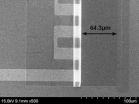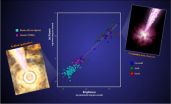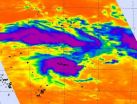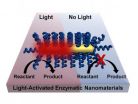(Press-News.org) Peach growers in California may soon have better tools for saving water because of work by U.S. Department of Agriculture (USDA) scientists in Parlier, Calif.
Agricultural Research Service (ARS) scientist Dong Wang is evaluating whether infrared sensors and thermal technology can help peach growers decide precisely when to irrigate in California's San Joaquin Valley. ARS is USDA's principal intramural scientific research agency, and the research supports the USDA priority of promoting international food security.
Irrigation is the primary source of water for agriculture in the valley during the summer, and wells have been forced to reach deeper to bring up enough water to meet increasing demands. Peaches also require much of their water from June through September, when temperatures and demands for water are at their highest.
Wang and Jim Gartung, an ARS agricultural engineer, installed 12 infrared temperature sensors in peach orchards at the San Joaquin Valley Agricultural Sciences Center in Parlier and gave trees one of four irrigation treatments: applying furrow or subsurface drip irrigation, with or without postharvest water stress.
They also measured crop yields and assessed the quality of the fruit to compare the output of trees grown under deficit irrigation with trees grown under normal conditions. Deficit irrigation has been used to produce some varieties of grapes and has been studied for its potential in fruit tree and row crop production. But it has yet to be widely adopted, in part because growers need better tools to strike a balance between saving water and keeping crops viable and healthy, according to Wang.
They used the sensors to measure temperatures in the tree canopies, and calculated a "crop water stress index" based on the differences between tree canopy temperatures and the surrounding air temperatures. Higher index numbers indicated more stressed trees.
The researchers found that midday canopy-to-air temperature differences in trees that were water-stressed postharvest were in the 10- to 15-degree Fahrenheit range, consistently higher than the 3- to 4-degree Fahrenheit range in the trees that were not water-stressed.
For comparison purposes, the researchers placed leaves from stressed and non-stressed trees in a pressure chamber and measured the pressure required to squeeze water out of them. When the trees are water-stressed, it takes more pressure to squeeze moisture from them.
The results show that the pressure chamber results were consistent with data collected by the infrared sensors, which means the sensors may be an effective tool for managing water use in peach orchards.
INFORMATION:
Read more about this research in the November/December 2012 issue of Agricultural Research magazine.
http://www.ars.usda.gov/is/AR/archive/nov12/peach1112.htm
USDA is an equal opportunity provider and employer. To file a complaint of discrimination, write: USDA, Office of the Assistant Secretary for Civil Rights, Office of Adjudication, 1400 Independence Ave., SW, Washington, DC 20250-9410 or call (866) 632-9992 (Toll-free Customer Service), (800) 877-8339 (Local or Federal relay), (866) 377-8642 (Relay voice users).
END
The plague-causing bacteria Yersinia pestis evades detection and establishes a stronghold without setting off the body's early alarms.
New discoveries reported this week help explain how the stealthy agent of Black Death avoids tripping a self-destruct mechanism inside germ-destroying cells.
The authors of the study, appearing in the Dec. 13 issue of Cell Host & Microbe, are Dr. Christopher N. LaRock of the University of Washington Department of Microbiology and Dr. Brad Cookson, UW professor of microbiology and laboratory medicine.
Normally, certain defender cells ...
A venomous primate with two tongues would seem safe from the pet trade, but the big-eyed, teddy-bear face of the slow loris (Nycticebus sp.) has made them a target for illegal pet poachers throughout the animal's range in southeastern Asia and nearby islands. A University of Missouri doctoral student and her colleagues recently identified three new species of slow loris. The primates had originally been grouped with another species. Dividing the species into four distinct classes means the risk of extinction is greater than previously believed for the animals but could ...
CHAMPAIGN, Ill. — On the road to smaller, high-performance electronics, University of Illinois researchers have smoothed one speed bump by shrinking a key, yet notoriously large element of integrated circuits.
Three-dimensional rolled-up inductors have a footprint more than 100 times smaller without sacrificing performance. The researchers published their new design paradigm in the journal Nano Letters.
"It's a new concept for old technology," said team leader Xiuling Li, a professor of electrical and computer engineering at the University of Illinois.
Inductors, ...
Black holes range from modest objects formed when individual stars end their lives to behemoths billions of times more massive that rule the centers of galaxies. A new study using data from NASA's Swift satellite and Fermi Gamma-ray Space Telescope shows that high-speed jets launched from active black holes possess fundamental similarities regardless of mass, age or environment. The result provides a tantalizing hint that common physical processes are at work.
"What we're seeing is that once any black hole produces a jet, the same fixed fraction of energy generates the ...
VIDEO:
NASA's TRMM satellite passed above an intensifying Tropical Cyclone Evan on Dec. 11 at 1759 UTC (12:59 p.m. EST/U.S.) and saw the tallest thunderstorms around Evan's center of circulation reached...
Click here for more information.
NASA satellites have been monitoring Tropical Cyclone Evan and providing data to forecasters who expected the storm to intensify. On Dec. 13, Evan had grown from a tropical storm into a cyclone as NASA satellites observed cloud formation, ...
HOUSTON – (Dec. 13, 2012) – Since Edison's first bulb, heat has been a mostly undesirable byproduct of light. Now researchers at Rice University are turning light into heat at the point of need, on the nanoscale, to trigger biochemical reactions remotely on demand.
The method created by the Rice labs of Michael Wong, Ramon Gonzalez and Naomi Halas and reported today in the American Chemical Society journal ACS Nano makes use of materials derived from unique microbes – thermophiles – that thrive at high temperatures but shut down at room temperature.
The Rice project ...
CHAMPAIGN, lll. — Every time a human or bacterial cell divides it first must copy its DNA. Specialized proteins unzip the intertwined DNA strands while others follow and build new strands, using the originals as templates. Whenever these proteins encounter a break – and there are many – they stop and retreat, allowing a new cast of molecular players to enter the scene.
Scientists have long sought to understand how one of these players, a repair protein known as RecA in bacterial cells, helps broken DNA find a way to bridge the gap. They knew that RecA guided a broken ...
TORONTO, Dec. 13, 2012—There's new evidence about the benefits of marriage.
Women who are married suffer less partner abuse, substance abuse or post-partum depression around the time of pregnancy than women who are cohabitating or do not have a partner, a new study has found.
Unmarried women who lived with their partners for less than two years were more likely to experience at least one of the three problems. However, these problems became less frequent the longer the couple lived together.
The problems were most common among women who were separated or divorced, especially ...
ARLINGTON, Va.—The Navy's chief of naval research, Rear Adm. Matthew Klunder, met this week with leaders from U.S. and Canadian government agencies to address research efforts in the Arctic, in response to dramatic and accelerating changes in summer sea ice coverage.
"Our Sailors and Marines need to have a full understanding of the dynamic Arctic environment, which will be critical to protecting and maintaining our national, economic and security interests," said Klunder. "Our research will allow us to know what's happening, to predict what is likely to come for the region, ...
Louisiana child custody, how do courts decide?
Divorce creates many life changes for divorcing spouses and their children. Louisiana couples going through divorce have many things to think about. Child custody is likely at the front of their minds. There are many factors that go into a child custody decision, but the process can be challenging and complex. That's why it's helpful to have an experienced family law attorney to offer guidance through the process.
What types of child custody exist in Louisiana?
When courts make a child custody determination they look ...





